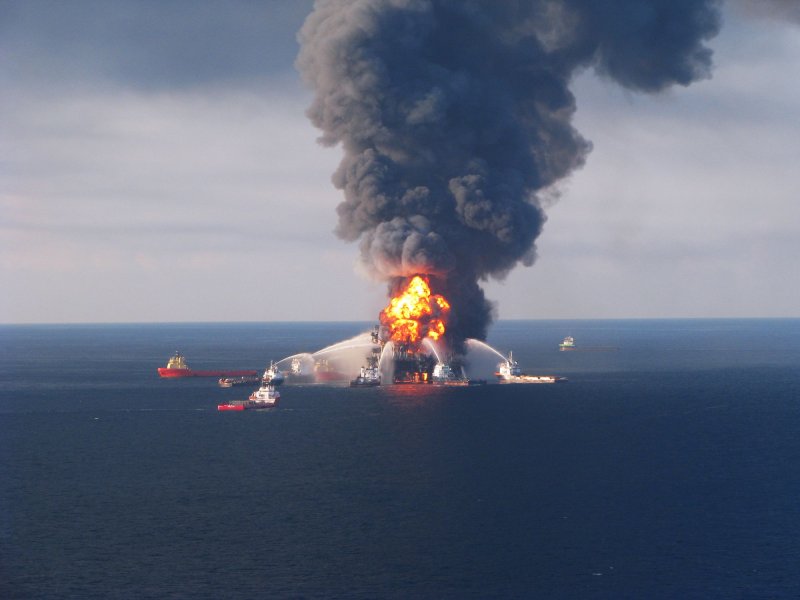1 of 3 | Fire boat response crews battle the blazing remnants of off shore oil rig Deepwater Horizon off the coast of New Orleans, Louisiana on April 21, 2010. 11 workers are missing after the oil rig exploded on April 20. UPI/U.S. Coast Guard |
License Photo
NEW ORLEANS, April 23 (UPI) -- Efforts were under way Friday to stop crude oil leaking from the site of an explosion-toppled oil rig in the Gulf of Mexico, officials said.
New Orleans' WWL-TV reported crude oil appeared to have spread more than 5 miles from the Deepwater Horizon accident site off the Louisiana coast. By Thursday night, an estimated 500,000 feet of boom had been laid out in the gulf to collect the oil on the surface, with another 500,000 feet of protective barrier expected to be stretched out Friday, the TV station said.
Crews were trying to cap the well below the surface and Louisiana Gov. Bobby Jindal announced the state has activated its crisis action team.
David Rainey, vice president for British Petroleum, which had contracted with TransOcean, a Swiss company that operated the rig that exploded Tuesday leaving 11 people missing, said the situation "certainly has the potential to be a major spill."
Tony Hayward, BP Group's chief executive, vowed to do everything possible to limit the spill.
"We are determined to do everything in our power to contain this oil spill and resolve the situation as rapidly, safely and effectively as possible," Hayward said in a statement. "We have assembled and are now deploying world-class facilities, resources and expertise, and can call on more if needed. There should be no doubt of our resolve to limit the escape of oil and protect the marine and coastal environments from its effects."
Rainey said it was uncertain whether 700,000 gallons of diesel fuel stored in barrels atop the structure were still intact or leaking into the gulf.
Dr. Luann White, a toxicologist consultant for the Louisiana Department of Public Health, said the spill "could potentially impact" oyster beds, fish and other wildlife.
"Some of the heavier crude oil is going to sink down below the surface where it's going to be much more difficult to recover," White said.
Rescue crews covered nearly 2,000 square miles looking for the missing workers since multiple explosions sent the rig tumbling into the sea. U.S. Coast Guard Rear Adm. Mary Landry and TransOcean Vice President Adrian Rose both said there was little chance of finding them alive.
The (New Orleans) Times-Picayune reported the disaster has already led to litigation, with suits filed on behalf of the families of missing workers Shane Roshto of Amite, Miss., and Karl Kleppinger of Natchez, Miss.
Deputy U.S. Interior Secretary David Hayes said the Coast Guard and federal Minerals Management Service have begun an investigation into what caused the explosion, The Times-Picayune said.
"Our focus now is preserving evidence and making sure that we will be able to do a thorough and complete evaluation of what happened here," Hayes said. "It's in our national interest to know exactly what went wrong to ensure something like this never happens again."
President Barack Obama has ordered the federal agencies to provide the resources need to deal with the situation.















